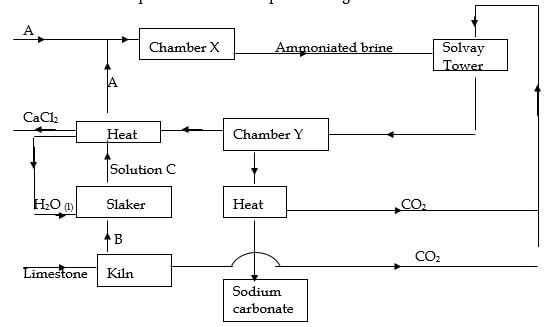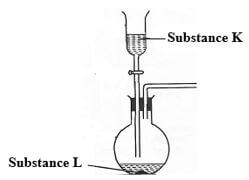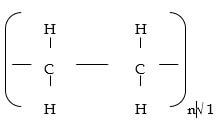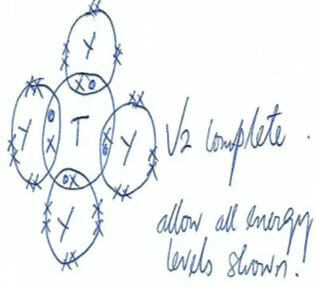INSTRUCTIONS TO CANDIDATES
- Write your Name, Admission Number and School in the spaces provided above.
- Answer all the questions in the spaces provided after each question.
- Mathematical tables and non-programmable electronic calculators may be used.
- ALL working must be clearly shown where necessary.
FOR EXAMINER’S USE ONLY
| QUESTIONS | MAX SCORE | CANDIDATE’S SCORE |
| 1 | 12 | |
| 2 | 12 | |
| 3 | 10 | |
| 4 | 11 | |
| 5 | 14 | |
| 6 | 10 | |
| 7 | 11 | |
| TOTAL | 80 |

QUESTIONS
-
- Study the flow chart below and answer the questions that follow.

- Name the process taking place in step (I). (1mark)
- Describe a chemical test that can be carried out to show the identity of organic compound A.(2marks)
- Give the name of the following: (2marks)
- A:…………………………………………………………………………………
- B:…………………………………………………………………………………
- Give the structural formulae of substance C. (1mark)
- Name the type of reaction that occurs in:
- Step IV (2marks)
- Step VI:
- Give the reagent and the condition necessary for step VI. (2marks)
Reagent:…………………………………………………………………………………………………
Condition:………………………………………………………………………………………………
- Give the systematic names of the following compounds:
- CH2CHCHCH2CH3 (1mark)
- CH C CH3 (1mark)
- Study the flow chart below and answer the questions that follow.
-
- The results below were obtained in an experiment conducted by form 3 students from Tigityo Secondary school using Magnesium.
- Mass of the crucible + lid = 19.52g
- Mass of the crucible + lid + Magnesium Ribbon = 20.36g
- Mass of the crucible + lid + Magnesium oxide = 20.92g
- Use the results to find the percentage mass of Magnesium & Oxygen in Magnesium oxide(2 marks)
- Determine the empirical formula of magnesium oxide. (Mg=24.0,O=16.0) (3 marks)
- Sodium hydroxide pellets were accidentally mixed with sodium chloride 8.8g of the mixture were dissolved in water to make one litre of solution. 50cm3 of the solution was neutralised by 20cm3 of 0.25M sulphuric acid.
- Write an equation for the reaction that took place. (1 mark)
- Calculate the:
- number of moles of the substance that reacted with sulphuric acid. (2 marks)
- number of moles of the substance that would react with sulphuric acid in the one litre solution (2 marks)
- the percentage of sodium chloride in the mixture. (2 marks)
(H=1.0; Na=23.0; Cl=35.5; O=16.0)
- The results below were obtained in an experiment conducted by form 3 students from Tigityo Secondary school using Magnesium.
-
- Study the table below and answer the questions that follow
Bond type bond energy kJmol-1
C-C 346
C = C 610
C-H 413
C-Br 280
Br-Br 193- Calculate the enthalpy change for the following reaction (3 marks)
C2H4(g) + Br2(g) → C2H4Br2(g) - Name the type of reaction that took place in (a) above (1mark)
- Calculate the enthalpy change for the following reaction (3 marks)
- Butane C4H10 cannot be prepared directly from its elements but its standard heat of formation (∆Hʄθ) can be obtained indirectly.
The following heats of combustion are given.
∆HCθ (Carbon) = -393kJ/mol
∆HCθ (Hydrogen) = -286kJ/mol
∆HCθ(Butane) =-2877kJ/mol- Draw an energy cycle diagram linking the heat of formation of butane with its heat of combustion and the heat of combustion of its constituents elements. (1mark)
- Calculate the heat of formation of butane ∆Hʄθ(C4H10) (2marks)
- Given that the lattice enthalpy of potassium chloride is +690kJ/mol and hydration enthalpies of K+ and Cl- are -322kJ and -364kJ respectively. Calculate the enthalpy of solution of potassium chloride. (3 marks)
- Study the table below and answer the questions that follow
-
- Name two apparatuses that can be used for determining accurate volume in a laboratory (2marks)
- One of the flames produced by Bunsen burner is the luminous flame
- Explain why this flame is very bright (1mark )
- State two disadvantages of the luminous flame (2marks)
- Air is usually one of the substances that is considered as a mixture
- Identify the two most abundant component of air (2marks)
- Give two reasons why the air is considered as a mixture (2marks)
- One of the components of air is carbon (iv) oxide. Describe an experiment that can be used to prove the presence of carbon (iv) oxide in the air (2marks)
- The grid below forms part of the periodic table. Study it and answer the questions that follow. The letters do not represent the actual symbols of the elements

- Write the general name given to the element P belong. (1mark)
- An element N has an atomic number of 15. Write down its electronic arrangement and hence fix it in its right position on the grid above. (2marks)
Electronic arrangement ………………………………………………………………………… - Compare the size of the atom of R and that of its ion. Explain your answer. (2marks)
- Give the formula of the compound formed between (1mark)
- P and W …………………………………………………………………………
- T and Y …………………………………………………………………………..
- Compare the melting points of element Q and S. Explain (2marks)
- State the least reactive element in the grid. Give a reason for your answer (2marks)
- Give two advantages that element S has over element Q in making electric cables(2mks)
- Draw (a) dot (.) and cross (x) diagram to represent the bonding in compound formed between T and Y (2 marks)
- The chart below represents the main steps in the large-scale manufacture of sodium carbonate.

- Name substances A and B.
A ………………………………………………………… (1 mark )
B ………………………………………………………… ( 1 mark) - Write down the chemical equation leading to formation of C. (1 mark )
- A stream of cold water is made to circulate around chamber X. What does this suggest about the reaction taking place.
(1 mark ) - Name the process that takes place in chamber Y. (1 mark)
- State any 2 by-products recycled in the process. (2 marks)
- In an experiment, wood charcoal was mixed with concentrated sulhuric (VI) acid in a test-tube. The mixture was then placed over a Bunsen-burner flame for sometime.
- Write down the chemical equation of the reaction that takes place. (1 mark)
- State the property of concentrated sulphuric (VI) acid investigated in (i) above. (1 mark)
- Mention any 2 uses of sodium carbonate. ( 1 mark )
- Name substances A and B.
- The set-up below can be used to generate a gas.

-
- Complete the table below giving the names of substance K and L if the gases generated are carbon (IV) oxide and carbon (II) oxide. (2marks)
Substance Carbon (IV) oxide Carbon (II) oxide K L - Complete the diagram to show how a sample of carbon (II) oxide can be collected. (2marks)
- State two ways that can be used to distinguish carbon (IV) oxide from carbon (II) oxide? (2 marks)
- Complete the table below giving the names of substance K and L if the gases generated are carbon (IV) oxide and carbon (II) oxide. (2marks)
-
- In an experiment, carbon (IV) oxide gas was passed over heated charcoal held in a combustion tube. Write a chemical equation for the reaction that took place in the combustion tube. (1 mark)
- State one use of carbon (II) oxide. (1 mark)
- The following set ups were used by Form Two students. Study and use them to answer the questions that follow.

State and explain the difference in observation made in set up I and II above. (3 marks)
-

MARKING SCHEME
-
-
- Cracking√ 1
- When the gas is burnt in air√ 1 it burns with a pale blue flame. √ 1
OR
Does not decolourize √ 1purple acidified potassium manganate (VII). √ 1 - I. A. Ethane√ 1
II. B 1- Chloroethane√ 1 
-
- Combustion√ 1
- Dehydration√ 1
- Conc. H2SO4√ 1
Temperature of 1700C. √ 1
-
- Pent-2-ene√ 1
- Prop-1-yne. √ 1
-
-
-
- Mass of Mg is 20.36-19.52=0.84g√ ½
Mass of MgO is 20.92-19.52=1.40g
Mass of oxygen is 20.92-20.36=0.56g√ ½
% mass of Mg in MgO is 0.84/1.40×100%
=60%√ ½
%mass of O2 in MgO is 0.56/1.40×100%
=40%√ ½ -
Empirical formula is thus MgO√ 1Elements Mg O %comp 60 40 R. A. M 24 16 Moles 60÷ 24 =2.5
40 ÷ 16 = 2.5 Mole ratio 1√ 1 1√ 1
- Mass of Mg is 20.36-19.52=0.84g√ ½
-
- 2NaOH(aq) +H2SO4(aq) → Na2SO4(aq) +2H2O(l) √ 1
-
- Moles of H2SO4 in 20cm3 is (20×0.25)/1000
=0.005moles√ 1
Mole ratio of base to acid is 2:1
Moles of NaOH is thus 2/1×0.005
=0.01 moles of NaOH√ 1 - Moles of NaOH in 1L is thus
(0.01×1000)/50 √ 1
=0.2moles√ 1 - Mass of NaOH in 1L is
0.2×40 =8g
Mass of NaCl in the mixture is 8.8-8= 0.8g√ 1
% mass of NaCl is 0.8⁄8.8×100%
= 9.09%√ 1
- Moles of H2SO4 in 20cm3 is (20×0.25)/1000
-
-
-
- Bonds Broken are 4C-H= 4 x 413 = 1652
1C = C = 1 x 610 =610
1Br – Br = 1 x 193 = 193
Total energy absorbed = 2455 kJmol-1 √ 1
Bonds formed are 4C-H= 4 x 413 = 1652
2C = Br = 2 x 280 =560
1C – C = 1 x 346 = 346
Total energy given out = 2558 kJmol-1 √ 1
∆H = 2455 – 2558 = -103 kJmol-1 √ 1 - Addition reaction √ 1
- Bonds Broken are 4C-H= 4 x 413 = 1652
-

∆Hfθ(C4H10) = ∆H3 - ∆H2
=4 (-393) + 5(-286) – (-2877) √1
= -3002 + 2877
= -125 kJmol-1 √1- ∆H +∆Hhyd
= 690 + -322 + - 364
= 690- 686
= + 4 kJ / mol
-
-
- √ 1
- Burrete √ 1
- Pippete√ 1
- Measuring cylinder
-
- Due to incomplete combustion, it produces white hot carbon particles that emittes a lot of light √ 1
- It produces soot that makes apparatus dirty √ 1
It does not produce much heat √ 1
-
- Nitrogen √ 1and oxygen√ 1
- It can be separated by physical means √ 1
Components of air are not chemically combined √ 1 - Pass air through lime water (Ca(OH)2√)√ 1 the lime water forms white precipitate indicating presence of carbon(IV)oxide √ 1
- √ 1
-
- Alkali metals √ 1
- Electron arrangement 2.8.5 √1
position: group V period 3√1 - The atom of R is larger √ ½ // has a larger atomic radius than the ion √ ½ This is because the ion of R is formed when the atom loses the electrons in the outermost energy level √ ½ therefore, the ion has one less energy level than the atom.√ ½
-
- P2W √ ½
- TY4 √ ½
- S has a higher √ ½ melting point than Q √ ½
This is because e S has more valence electrons in its metallic structure hence a stronger metallic bond √ ½ than Q √ ½ - M √1
It has a completely filled outermost energy level √ ½ and therefore, does not need to react with other elements to gain stability √ ½ - S has a higher electrical conductivity than Q√ 1.
S does not corrode easily like Q. √ 1 -

-
- A – Ammonia √1
B – Calcium oxide √1 - CaO (s) + H2O (l) → Ca(OH)2 (aq) √1
- Reaction is exothermic √1
- Filtration √1
- - Ammonia √1
- Carbon (IV) oxide √1 -
- C (s) + 2H2SO4 (l) → CO2 (g) + 2H2O (l) + 2SO2 (g) √1
- Oxidising property √1
-
- Manufacture of glass√½
- Softening of hard water √½
- Making of soaps and detergents
- For making sodium hydrogen carbonate used in baking soda and fire extinguishers
(Any 2 correct answers each ½ mk )
- A – Ammonia √1
-
-
-
Substance Carbon (IV) oxide Carbon (II) oxide K Dilute hydrochloric acid √½ Concentrated sulphuric (VI) acid √½ L Marble chips or calcium carbonate √½ Sodium methanoate or ethanedioc acid (oxalic acid) √½ -

Complete diagram = 1 mark, Labelling = 1 mark - Carbon (IV) oxide reacts with lime water / calcium hydroxide solution√½ to yield
white precipitate while carbon (II) oxide does not. √½
Carbon (II) oxide burns √½with blue flame while carbon (IV) oxide does not burn. √½
-
-
- CO2(g) + C(s) → 2CO(g) √1
- Reducing agent in extraction of some metals from their oxides. √1
- The bulb lights in set up I or conducts electricity while set up II does not. √ √1
In graphite, three out of four valence electrons of carbon atom are bonded leaving one delocalised√1 electron thus conducts electricity while in diamond, all the four valence electrons are bonded and is without delocalised electrons. √1
-
Join our whatsapp group for latest updates
Tap Here to Download for 50/-
Get on WhatsApp for 50/-
Download Chemistry Paper 2 Questions and Answers - Sunrise Evaluation Pre Mock Exams 2021.
Tap Here to Download for 50/-
Get on WhatsApp for 50/-
Why download?
- ✔ To read offline at any time.
- ✔ To Print at your convenience
- ✔ Share Easily with Friends / Students

